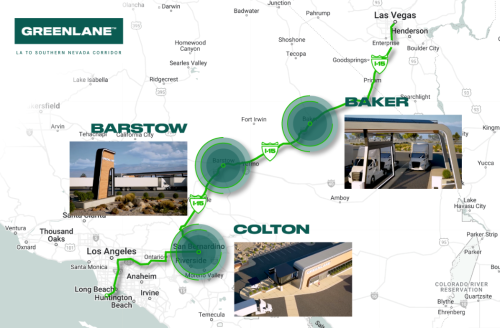The new charging corridor along Interstate 15 aims to accelerate the rollout of carbon-neutral freight transportation with initial charging locations in Colton, Barstow and Baker, California. Over the next year, further locations will be added along the corridor, extending beyond Southern Nevada and to San Pedro in California.

At full build, the Colton site is planned to have more than 60 chargers, including 400 kW Direct Current Fast Chargers (DCFC) to speed charging of medium- and heavy-duty zero-emission vehicles (ZEVs). More 200 kW DCFC charging options onsite will enable long-duration and overnight charging for heavy-duty tractors, medium-duty ZEVs and school buses. Greenlane will also deploy multiple passenger car charging stalls to support light-duty and passenger vehicles.
Later project phases will support both long-duration and overnight charging lanes for tractor-trailer combinations. The Greenlane site in Colton will also be future-proofed to accommodate the Megawatt Charging System (MCS) when commercially available.
By using a predictive modeling tool to simulate truck traffic and energy flow at the site, we can determine how many chargers are necessary to meet the regional demand based on vehicle characteristics and departure and arrival times for vehicles hauling freight along this corridor. Our findings indicated that placing the three stations approximately 60 to 90 miles apart would maximize uptime for day-cab drivers by enabling shorter charging sessions at each stop and ultimately allowing customers to move freight confidently without any limitations.
—Patrick Macdonald-King, CEO of Greenlane
Designed to upgrade and enhance the current rest stop experience, each Greenlane site will have wide pull-through lanes, allowing drivers to enter and exit the property quickly and easily. While waiting for vehicles to charge, drivers can access modern facilities, with restrooms and other amenities, including food and beverage options.
Greenlane aims to develop a nationwide network of commercial charging infrastructure locations across the US. The charging sites will also serve battery-electric passenger car and light-duty fleet customers and are designed to provide hydrogen refueling for commercial vehicles in the coming years.